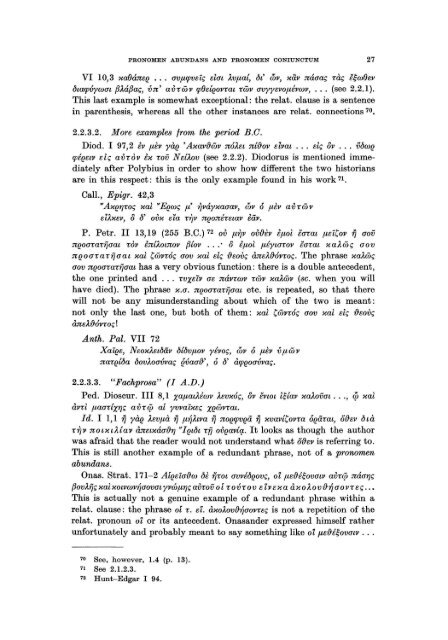Pronomen Abundans and Pronomen Coniunctum. A ... - DWC
Pronomen Abundans and Pronomen Coniunctum. A ... - DWC
Pronomen Abundans and Pronomen Coniunctum. A ... - DWC
You also want an ePaper? Increase the reach of your titles
YUMPU automatically turns print PDFs into web optimized ePapers that Google loves.
PRONOMEN ABUNDANS AND PRONOMEN CONIUNCTUM 27<br />
VI 10,3 xaOánee ... aVfupveïÇ elat ÀVflat, {U' djv, xav náaaç 'l'àç l~wOev<br />
(jwqnJywat {3M{3aç, vn' av'l'wv q;OeteOV'l'at 'l'WV avyyevoflévwv, ... (see 2.2.1).<br />
This last example is somewhat exceptional: the relat. clause is a senten ce<br />
in parenthesis, whereas all the other instances are relat. connections 70.<br />
2.2.3.2. More examples trom the period B.O.<br />
Diod. I 97,2 lv fliv yàe ' Axavifwv nóÀet ntifov elvat ... elç OV ... {J(jwe<br />
q;éeetV elç av'l'ov lx 'l'OV N etÀov (see 2.2.2). Diodorus is mentioned immediately<br />
af ter Polybius in order to show how different the two historians<br />
are in this respect: th is is the only example found in his work 71 .<br />
CaU., Epigr. 42,3<br />
... Axe1J'l'Oç xal ... Eewç fl' Ijváyxaaav, djv Ó fliv av'l'WV<br />
elÀxev, 0 (j' ovx era 'l'ijv neoné-retav Niv.<br />
P. Petr. II 13,19 (255 B.C.) 72 OV flijV ovifiv lflOl la'l'at fleïCov ij aov<br />
neoa'l'a'l'fjaat 'l'OV lntÀotnov {3tov .... 0 lflOl fléyta'l'ov la'l'at xaÀwç aov<br />
neoa'l'a'l'fjaat xal CWV'l'Óç aov xal elç ifeovç àneÀifóv'l'oç. The phrase xaÀwç<br />
aov neoa'l'a'l'fjaat has a very obvious function: there is a double antecedent,<br />
the one printed <strong>and</strong> .. . 'l'VXeiv ae náv'l'wv 'l'WV xaÀwv (sc. when you will<br />
have died). The phrase x.a. neoa'l'a'l'fjaat etc. is repeated, so that there<br />
will not be any misunderst<strong>and</strong>ing about which of the two is meant:<br />
not only the last one, but both of them: xal CWV'l'Óç aov xal elç ifeovç<br />
ànûifóv'l'oç!<br />
Anth. Pal. VII 72<br />
Xa'iee, NeoxÀetè3äv M(jVfloV yévoç, djv Ó fliv VflwV<br />
na'l'et(ja (jovÀoavvaç évaaif', Ó (j' àrpeoavvaç.<br />
2.2.3.3. "Fachprosa" (I A .D.)<br />
Pedo Dioscur. III 8,1 XaflatUwv Àevxóç, OV lvlOt l~tav xaÀovat ..., cp xal<br />
àvû flaa-rtX1Jç avnp at yvva'ixeç xeWV'l'at.<br />
Id. I 1,1 ij yàe ÀêVflà ij fl~ÀtVa ij noerpveii ij xvaviCov'l'a Óeii'l'at, öifev (jtà<br />
'l'~V notxtÀiav ànetxáaif1J "Iet(jt 'l'f} oveavtq.. It looks as though the author<br />
was af raid that the reader would not underst<strong>and</strong> what öifev is referring to.<br />
This is still another example of a redundant phrase, not of a pronomen<br />
abundans.<br />
Onas. Strat. 171-2 Ateeïaifw (ji ij'l'Ot avvé(jeovç, or fleifé~ovatv avnp náa1Jç<br />
{3ovÀijç xal Xotvwv~aovat yvwfl1JÇ av-rov 0 t 'l'OV'l'OV elve xa àxoÀovif~ aovuç ...<br />
This is actually not a genuine example of a redundant phrase within a<br />
relat. clause: the phrase Ot 'l'. el. àxoÀovif-,]aov-reç is not a repetition of the<br />
relat. pronoun ol or its antecedent. Onas<strong>and</strong>er expressed himself rather<br />
unfortunately <strong>and</strong> probably meant to say something like or fleifé~ovatv .. .<br />
70 See, however, 1.4 (p. 13).<br />
71 See 2.1.2.3.<br />
72 Hunt-Edgar I 94.
















